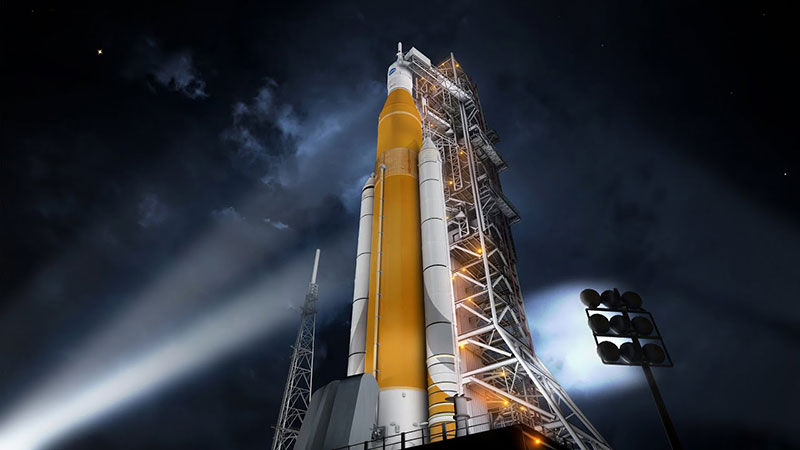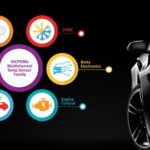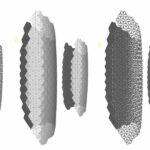After the privately-led lunar probe “Peregrine” announced the abandonment of its lunar landing mission on the 9th, NASA reluctantly stated that the Artemis manned moon landing program would be significantly delayed. NASA officials, in a press conference, cited delays in technological progress as the main reason for the challenges in the timely progress of the U.S. return to the moon. Analysts speculate that the repeated delays in the U.S. manned lunar program could lead to concerns from other countries associated with the Artemis program.
“Orion” Spacecraft Faces Three Major Hazards
On the 10th, the U.S. “Space News” website reported that NASA Administrator Bill Nelson announced that the manned lunar mission “Artemis II” would be delayed from the end of 2024 to no earlier than September 2025, and the manned lunar mission “Artemis III” would be delayed from the end of 2025 to no earlier than September 2026.
Nelson emphasized, “Safety is our top priority. To give the Artemis team more time to address challenges, we will allocate more time for Artemis II and Artemis III.”
According to NASA’s plan, “Artemis II” will carry four astronauts on a complex orbit around the moon and return to Earth. This will be the first manned flight test of the “Orion” spacecraft and the SLS rocket, and the first-time humans leave low Earth orbit since 1972.
The report stated that Amit Kshatriya, NASA’s deputy director responsible for the moon to Mars program, mentioned three specific issues leading to the delay of “Artemis II.” The first is the unexpected erosion of the heat-resistant material on the unmanned “Orion” spacecraft during the return to the atmosphere in the “Artemis I” mission in December 2022. Kshatriya revealed that NASA has made progress in understanding the causes of the erosion and expects to identify the root cause in the spring of this year. However, more time is needed to solve the problem before the spacecraft can fly again.
The second issue involves the life support system of the “Orion” spacecraft. Kshatriya stated, “We found a design flaw in the drive valve circuit during the spacecraft inspection.” These electronic devices affect many parts of the spacecraft’s life support system, including the system for removing carbon dioxide. NASA ultimately decided to replace these electronic devices, which “takes a considerable amount of time.” According to regulations, to ensure flight safety, the completed spacecraft also needs additional testing. This work is one of the main reasons for NASA’s decision to delay the “Artemis II” mission to September 2025.
The third issue is related to the emergency escape system of the “Orion” spacecraft. In the event of a failure in the SLS rocket, this system can ensure that astronauts evacuate quickly. However, tests found “defects” in the spacecraft’s electrical system under certain conditions, and the assessment of this issue is still in the early stages.

Slow Progress of “Starship”
CNN reported on the 10th that the manned lunar mission “Artemis III,” the first human lunar landing in 50 years, faces more technical obstacles. According to NASA’s current plan, the “Artemis III” mission is more complex than the earlier Apollo lunar landing program: after being sent into space by the SLS rocket, the “Orion” spacecraft carrying four astronauts will fly directly to lunar orbit. The manned lunar lander “Starship,” developed by SpaceX, will be waiting there. The “Orion” spacecraft will dock with the lunar lander in lunar orbit, and two astronauts will descend to the landing site near the lunar south pole, while the other two astronauts will remain in the “Orion” spacecraft. After the lunar surface exploration is completed, the “Starship” lander will take off from the lunar surface to return to lunar orbit and dock again with the “Orion” spacecraft. The four astronauts will then return to Earth aboard the “Orion” spacecraft.
CNN stated that the slow progress of SpaceX’s “Starship” is a major reason for the delay of the “Artemis III” mission. The complete “Starship” system consists of a giant rocket and the “Starship” spacecraft. Both of its test flights in 2023 ended in explosions. NASA officials stated that “Starship” has not yet proven its ability to “safely send humans into space and return to Earth.” Before the “Artemis III” mission officially bes, it needs to undergo unmanned simulated lunar landing demonstrations. “This requires a lot of test flights for ‘Starship,’ which is difficult to complete before the originally planned date of December 2025.”
Jessica Jensen, Vice President of Customer Operations and Integration at SpaceX, stated that even after “Starship” proves its ability to safely enter Earth orbit, research is still needed on how to perform in-orbit refueling. According to the design, after taking off from Earth, the “Starship” lander first reaches a low Earth orbit several hundred kilometers above the Earth. Multiple modified “Starship” spacecraft in orbit then refuel with methane and liquid oxygen propellants to provide enough power to fly to lunar orbit. The fueling of these rocket propellants needs to be done in ultra-low-temperature conditions, and if there is not enough thermal insulation, intense sunlight in space can cause them to heat up rapidly and boil, greatly increasing the complexity of in-orbit storage and fueling. Therefore, in-orbit refueling is a key technology required for “Starship” to leave low Earth orbit. Due to the failure of the only two test flights of “Starship” so far, SpaceX has not had the opportunity to verify the progress of the related technology.

Early Stage of Development of Extravehicular Spacesuit
The “Space” website stated that another technical issue affecting the timely implementation of the “Artemis III” mission is that the extravehicular spacesuit used by lunar astronauts has not been completed on schedule. Vanessa Wyche, Director of NASA’s Johnson Space Center, said earlier last year, “Since we designed the spacesuit for space missions, we haven’t had a new spacesuit. The spacesuits currently in use are still used on the space station. So, for 40 years, we have been using the same spacesuit based on this technology.”
Vanessa Wyche stated that the new generation of extravehicular spacesuits being developed will play a key role in the “Artemis III” mission. After landing on the lunar south pole, the spacesuit will serve as a mobile life support device, allowing astronauts to explore the moon on foot. The spacesuit is equipped with high-definition cameras and lighting devices installed on the helmet visor. This will provide better visibility for astronauts when working or walking in the permanently shadowed areas near the lunar south pole. Retired NASA astronaut Peggy Whitson said that this will be a more flexible spacesuit that will truly enhance the ability of astronauts to complete tasks when exploring the lunar surface.
However, the development of NASA’s new generation of extravehicular spacesuits is not going smoothly. In August 2021, a report from the Office of Inspector General of NASA criticized, “Although NASA has been developing the next-generation extravehicular spacesuit for 14 years, its progress continues to be delayed by 20 months compared to the plan to deliver two sets of spacesuits in November 2024.” Under pressure to make progress, NASA was forced to outsource the development of the extravehicular spacesuit to Axiom Space.
NASA claims that the latter will develop the extravehicular spacesuit for the “Artemis” mission based on the prototype of NASA’s “Exploration Extravehicular Mobility Unit (xEMU).” However, Forbes reported in December 2023 that a report from the U.S. Government Accountability Office stated that although Axiom Space is developing the new spacesuit based on most of NASA’s previous data and experience, there is still “a lot of work to be done” to meet the “60-minute emergency life support capability,” and the spacesuit is still in the “early stages of development.”
Seizing the Initiative vs. Proceeding Step by Step
The “Space News” website introduced that as a key project for the United States to return to the moon, the “Artemis” program has brought together many important allies in the United States to seize the initiative in exploring space. The program emphasizes jointly completing lunar exploration and long-term stays on the moon with the power of private companies and “space allies,” ensuring that the United States stays at the forefront of lunar exploration by “keeping a long-term presence on the lunar surface.”
In addition, the U.S.-initiated “Artemis Accords,” which has been signed by more than 20 countries, has caused widespread controversy. The Accords establish a “safety zone” and confirm the use of “extraterrestrial resources,” among other content. Critics believe that its essence is that the United States is trying to establish exclusive rights for government space management agencies to conduct activities and commercial companies to enjoy resources in specific areas on the lunar surface, bypassing the provisions of the Outer Space Treaty that prohibit sovereign states from claiming sovereignty over the moon and outer space.
The “Space News” website stated that due to the multiple changes in the schedule of the U.S. “Artemis” program, there is increasing speculation about whether China will achieve “human return to the moon” before the United States.
However, several foreign media outlets have also noticed that while the United States is experiencing setbacks in returning to the moon, China is steadily progressing with its planned lunar exploration project. The China National Space Administration announced on the 10th that the Chang’e-6 probe has arrived at the Wenchang launch site and will be launched in the first half of this year.













Leave a comment